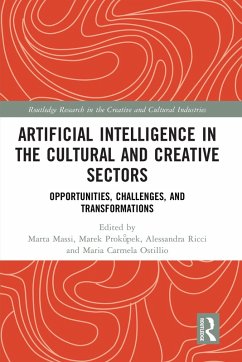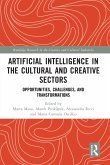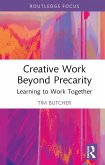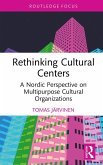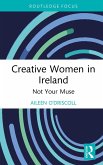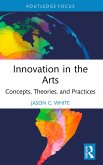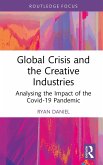Artificial Intelligence in the Cultural and Creative Sectors (eBook, ePUB)
Opportunities, Challenges, and Transformations
Redaktion: Massi, Marta; Ostillio, Maria Carmela; Ricci, Alessandra; Prokupek, Marek
42,95 €
42,95 €
inkl. MwSt.
Erscheint vor. 13.11.25

21 °P sammeln
42,95 €
Als Download kaufen

42,95 €
inkl. MwSt.
Erscheint vor. 13.11.25

21 °P sammeln
Jetzt verschenken
Alle Infos zum eBook verschenken
42,95 €
inkl. MwSt.
Erscheint vor. 13.11.25
Alle Infos zum eBook verschenken

21 °P sammeln
Artificial Intelligence in the Cultural and Creative Sectors (eBook, ePUB)
Opportunities, Challenges, and Transformations
Redaktion: Massi, Marta; Ostillio, Maria Carmela; Ricci, Alessandra; Prokupek, Marek
- Format: ePub
- Merkliste
- Auf die Merkliste
- Bewerten Bewerten
- Teilen
- Produkt teilen
- Produkterinnerung
- Produkterinnerung

Bitte loggen Sie sich zunächst in Ihr Kundenkonto ein oder registrieren Sie sich bei
bücher.de, um das eBook-Abo tolino select nutzen zu können.
Hier können Sie sich einloggen
Hier können Sie sich einloggen
Sie sind bereits eingeloggt. Klicken Sie auf 2. tolino select Abo, um fortzufahren.

Bitte loggen Sie sich zunächst in Ihr Kundenkonto ein oder registrieren Sie sich bei bücher.de, um das eBook-Abo tolino select nutzen zu können.
This book explores how AI is redefining the creative and cultural sectors, reshaping how content is produced, distributed, experienced, and managed. Spanning areas such as publishing, heritage, music, performance, and design, the book offers the first comprehensive, interdisciplinary examination of AI's impact across these diverse sectors as technologies become increasingly embedded in both creative and operational processes.
- Geräte: eReader
- mit Kopierschutz
- eBook Hilfe
- Größe: 0.95MB
Andere Kunden interessierten sich auch für
![Artificial Intelligence in the Cultural and Creative Sectors (eBook, PDF) Artificial Intelligence in the Cultural and Creative Sectors (eBook, PDF)]() Artificial Intelligence in the Cultural and Creative Sectors (eBook, PDF)42,95 €
Artificial Intelligence in the Cultural and Creative Sectors (eBook, PDF)42,95 €![Creative Work Beyond Precarity (eBook, ePUB) Creative Work Beyond Precarity (eBook, ePUB)]() Tim ButcherCreative Work Beyond Precarity (eBook, ePUB)19,95 €
Tim ButcherCreative Work Beyond Precarity (eBook, ePUB)19,95 €![Rethinking Cultural Centers (eBook, ePUB) Rethinking Cultural Centers (eBook, ePUB)]() Tomas JärvinenRethinking Cultural Centers (eBook, ePUB)19,95 €
Tomas JärvinenRethinking Cultural Centers (eBook, ePUB)19,95 €![Creative Women in Ireland (eBook, ePUB) Creative Women in Ireland (eBook, ePUB)]() Aileen O'DriscollCreative Women in Ireland (eBook, ePUB)24,95 €
Aileen O'DriscollCreative Women in Ireland (eBook, ePUB)24,95 €![Innovation in the Arts (eBook, ePUB) Innovation in the Arts (eBook, ePUB)]() Jason C. WhiteInnovation in the Arts (eBook, ePUB)19,95 €
Jason C. WhiteInnovation in the Arts (eBook, ePUB)19,95 €![Global Crisis and the Creative Industries (eBook, ePUB) Global Crisis and the Creative Industries (eBook, ePUB)]() Ryan DanielGlobal Crisis and the Creative Industries (eBook, ePUB)18,95 €
Ryan DanielGlobal Crisis and the Creative Industries (eBook, ePUB)18,95 €![Caribbean Industries in Culture (eBook, ePUB) Caribbean Industries in Culture (eBook, ePUB)]() Suzanne BurkeCaribbean Industries in Culture (eBook, ePUB)19,95 €
Suzanne BurkeCaribbean Industries in Culture (eBook, ePUB)19,95 €-
-
-
This book explores how AI is redefining the creative and cultural sectors, reshaping how content is produced, distributed, experienced, and managed. Spanning areas such as publishing, heritage, music, performance, and design, the book offers the first comprehensive, interdisciplinary examination of AI's impact across these diverse sectors as technologies become increasingly embedded in both creative and operational processes.
Dieser Download kann aus rechtlichen Gründen nur mit Rechnungsadresse in A, B, BG, CY, CZ, D, DK, EW, E, FIN, F, GR, HR, H, IRL, I, LT, L, LR, M, NL, PL, P, R, S, SLO, SK ausgeliefert werden.
Produktdetails
- Produktdetails
- Verlag: Taylor & Francis eBooks
- Seitenzahl: 300
- Erscheinungstermin: 13. November 2025
- Englisch
- ISBN-13: 9781040450703
- Artikelnr.: 75562668
- Verlag: Taylor & Francis eBooks
- Seitenzahl: 300
- Erscheinungstermin: 13. November 2025
- Englisch
- ISBN-13: 9781040450703
- Artikelnr.: 75562668
- Herstellerkennzeichnung Die Herstellerinformationen sind derzeit nicht verfügbar.
Marta Massi, PhD, is an Assistant Professor at Athabasca University, Canada. She previously held positions as Assistant Professor at Università Cattolica del Sacro Cuore and Trent University, and as Lecturer at McGill University. Her research focuses on consumer behavior, arts marketing, and branding. Her work has been published in leading journals such as Psychology & Marketing, International Journal of Market Research, Journal of Strategic Marketing, and Journal of Business & Industrial Marketing. Most recently, she edited the Routledge volume Digital Transformation in the Cultural and Creative Industries: Production, Consumption and Entrepreneurship in the Digital Economy and Sharing. Marek Prok¿pek is an Associate Professor in Arts Management at KEDGE Arts School at KEDGE Business School in France, where he is also a member of the Creative Industries & Culture Research Centre. His research interests lie primarily in the areas of innovative business models of arts and cultural organizations, museum fundraising and philanthropy and its ethical challenges, and the art market. Alessandra Ricci is Fellow of Marketing Management at SDA Bocconi School of Management. She has previously worked as a postdoctoral research fellow at IULM University, Milan, and held teaching and research positions at Bocconi University, the University of Gastronomic Sciences in Pollenzo, and the Catholic University of the Sacred Heart of Milan. Her research focuses on the high-end sector-including artisanship, luxury, and Made-in-Italy-through the lenses of marketing, sustainability, and value creation. She also has professional expertise in cultural heritage management and tourism. Maria Carmela Ostillio is an Associate Professor of Marketing and Sales at SDA Bocconi. She directs the Brand Academy and has led research projects in branding, marketing, and corporate communications. Her expertise includes brand management, direct marketing, and marketing information systems.
Foreword: Artificial Intelligence and Creativity
Chapter 1: Introduction to Artificial Intelligence in the Cultural and
Creative Sectors
Chapter 2: The Voyager, the Mirror, and the Creative Act. Three Metaphors
for Understanding Generative Artificial Intelligence.
Chapter 3: Artists in the Age of AI - A Typology of Human-Machine
Collaborations and Associated Imaginaries.
Chapter 4: Breathing Life into AI - Querying AI through Tactile Imprints
Using Breath and Sound.
Chapter 5: The Rise of "Alone Teamwork": Unveiling the Transformations in
the Creation Process of Artists Using Generative Artificial Intelligence
Tools.
Chapter 6: Imagination and AI: A Socio-Technical Reading of Artists as
Agents of Innovation in AI Development.
Chapter 7: Reviving Textile Heritage: AI-Driven Innovation Practices in
Museum Exhibitions.
Chapter 8: Contemporary Art and Biodiversity: The Impact of Artificial
Intelligence on Art Museum Collections.
Chapter 9: Mediation and Artificial Intelligence: Transdisciplinary
collaboration in the AI.MAGINATION Exhibition.
Chapter 10: Navigating AI in Museums: Overcoming Barriers and Implementing
Strategic Solutions.
Chapter 11: Augmenting the Stage: The Intersection Between AI and Theatre.
Chapter 12: Creating Stories with Generative AI in Film Education - The
Screenwriters' Room with Large Language Models (LLMs).
Chapter 13: Developing a Value Chain for Personalised Children's Book with
Support of Artificial Intelligence.
Chapter 14: Is This Really Disruption? An Organisational Perspective about
AI in the Book Industry.
Chapter 15: Unleashing Creativity: The Powerful Duo of Artificial
Intelligence and Brand Heritage.
Chapter 16: Redefining Luxury in the Age of Generative AI: Navigating
Innovation and Heritage in Brand Management.
Chapter 17: How Young Adults Perceive the Prevalence of Metahuman Artists.
Chapter 18: The Adoption of Generative Ai in Video Game Production: Firm
and Industry-Level Dynamics.
Afterword: Artificial Intelligence in Cultural and Creative Sectors
Chapter 1: Introduction to Artificial Intelligence in the Cultural and
Creative Sectors
Chapter 2: The Voyager, the Mirror, and the Creative Act. Three Metaphors
for Understanding Generative Artificial Intelligence.
Chapter 3: Artists in the Age of AI - A Typology of Human-Machine
Collaborations and Associated Imaginaries.
Chapter 4: Breathing Life into AI - Querying AI through Tactile Imprints
Using Breath and Sound.
Chapter 5: The Rise of "Alone Teamwork": Unveiling the Transformations in
the Creation Process of Artists Using Generative Artificial Intelligence
Tools.
Chapter 6: Imagination and AI: A Socio-Technical Reading of Artists as
Agents of Innovation in AI Development.
Chapter 7: Reviving Textile Heritage: AI-Driven Innovation Practices in
Museum Exhibitions.
Chapter 8: Contemporary Art and Biodiversity: The Impact of Artificial
Intelligence on Art Museum Collections.
Chapter 9: Mediation and Artificial Intelligence: Transdisciplinary
collaboration in the AI.MAGINATION Exhibition.
Chapter 10: Navigating AI in Museums: Overcoming Barriers and Implementing
Strategic Solutions.
Chapter 11: Augmenting the Stage: The Intersection Between AI and Theatre.
Chapter 12: Creating Stories with Generative AI in Film Education - The
Screenwriters' Room with Large Language Models (LLMs).
Chapter 13: Developing a Value Chain for Personalised Children's Book with
Support of Artificial Intelligence.
Chapter 14: Is This Really Disruption? An Organisational Perspective about
AI in the Book Industry.
Chapter 15: Unleashing Creativity: The Powerful Duo of Artificial
Intelligence and Brand Heritage.
Chapter 16: Redefining Luxury in the Age of Generative AI: Navigating
Innovation and Heritage in Brand Management.
Chapter 17: How Young Adults Perceive the Prevalence of Metahuman Artists.
Chapter 18: The Adoption of Generative Ai in Video Game Production: Firm
and Industry-Level Dynamics.
Afterword: Artificial Intelligence in Cultural and Creative Sectors
Foreword: Artificial Intelligence and Creativity
Chapter 1: Introduction to Artificial Intelligence in the Cultural and
Creative Sectors
Chapter 2: The Voyager, the Mirror, and the Creative Act. Three Metaphors
for Understanding Generative Artificial Intelligence.
Chapter 3: Artists in the Age of AI - A Typology of Human-Machine
Collaborations and Associated Imaginaries.
Chapter 4: Breathing Life into AI - Querying AI through Tactile Imprints
Using Breath and Sound.
Chapter 5: The Rise of "Alone Teamwork": Unveiling the Transformations in
the Creation Process of Artists Using Generative Artificial Intelligence
Tools.
Chapter 6: Imagination and AI: A Socio-Technical Reading of Artists as
Agents of Innovation in AI Development.
Chapter 7: Reviving Textile Heritage: AI-Driven Innovation Practices in
Museum Exhibitions.
Chapter 8: Contemporary Art and Biodiversity: The Impact of Artificial
Intelligence on Art Museum Collections.
Chapter 9: Mediation and Artificial Intelligence: Transdisciplinary
collaboration in the AI.MAGINATION Exhibition.
Chapter 10: Navigating AI in Museums: Overcoming Barriers and Implementing
Strategic Solutions.
Chapter 11: Augmenting the Stage: The Intersection Between AI and Theatre.
Chapter 12: Creating Stories with Generative AI in Film Education - The
Screenwriters' Room with Large Language Models (LLMs).
Chapter 13: Developing a Value Chain for Personalised Children's Book with
Support of Artificial Intelligence.
Chapter 14: Is This Really Disruption? An Organisational Perspective about
AI in the Book Industry.
Chapter 15: Unleashing Creativity: The Powerful Duo of Artificial
Intelligence and Brand Heritage.
Chapter 16: Redefining Luxury in the Age of Generative AI: Navigating
Innovation and Heritage in Brand Management.
Chapter 17: How Young Adults Perceive the Prevalence of Metahuman Artists.
Chapter 18: The Adoption of Generative Ai in Video Game Production: Firm
and Industry-Level Dynamics.
Afterword: Artificial Intelligence in Cultural and Creative Sectors
Chapter 1: Introduction to Artificial Intelligence in the Cultural and
Creative Sectors
Chapter 2: The Voyager, the Mirror, and the Creative Act. Three Metaphors
for Understanding Generative Artificial Intelligence.
Chapter 3: Artists in the Age of AI - A Typology of Human-Machine
Collaborations and Associated Imaginaries.
Chapter 4: Breathing Life into AI - Querying AI through Tactile Imprints
Using Breath and Sound.
Chapter 5: The Rise of "Alone Teamwork": Unveiling the Transformations in
the Creation Process of Artists Using Generative Artificial Intelligence
Tools.
Chapter 6: Imagination and AI: A Socio-Technical Reading of Artists as
Agents of Innovation in AI Development.
Chapter 7: Reviving Textile Heritage: AI-Driven Innovation Practices in
Museum Exhibitions.
Chapter 8: Contemporary Art and Biodiversity: The Impact of Artificial
Intelligence on Art Museum Collections.
Chapter 9: Mediation and Artificial Intelligence: Transdisciplinary
collaboration in the AI.MAGINATION Exhibition.
Chapter 10: Navigating AI in Museums: Overcoming Barriers and Implementing
Strategic Solutions.
Chapter 11: Augmenting the Stage: The Intersection Between AI and Theatre.
Chapter 12: Creating Stories with Generative AI in Film Education - The
Screenwriters' Room with Large Language Models (LLMs).
Chapter 13: Developing a Value Chain for Personalised Children's Book with
Support of Artificial Intelligence.
Chapter 14: Is This Really Disruption? An Organisational Perspective about
AI in the Book Industry.
Chapter 15: Unleashing Creativity: The Powerful Duo of Artificial
Intelligence and Brand Heritage.
Chapter 16: Redefining Luxury in the Age of Generative AI: Navigating
Innovation and Heritage in Brand Management.
Chapter 17: How Young Adults Perceive the Prevalence of Metahuman Artists.
Chapter 18: The Adoption of Generative Ai in Video Game Production: Firm
and Industry-Level Dynamics.
Afterword: Artificial Intelligence in Cultural and Creative Sectors
